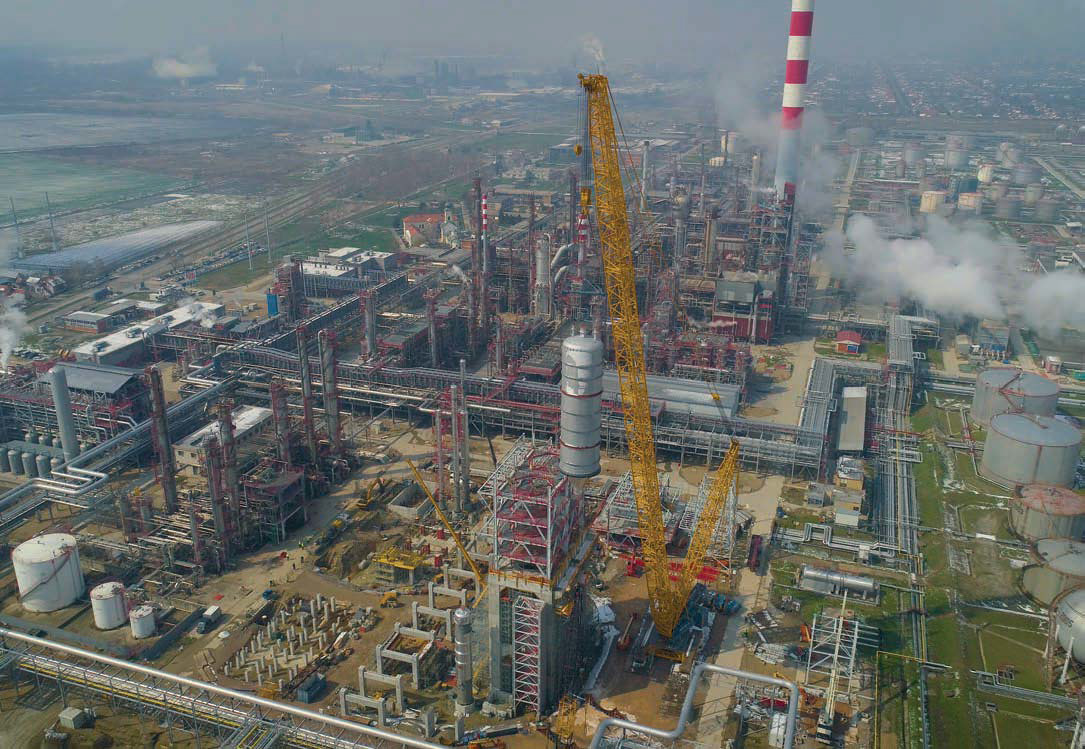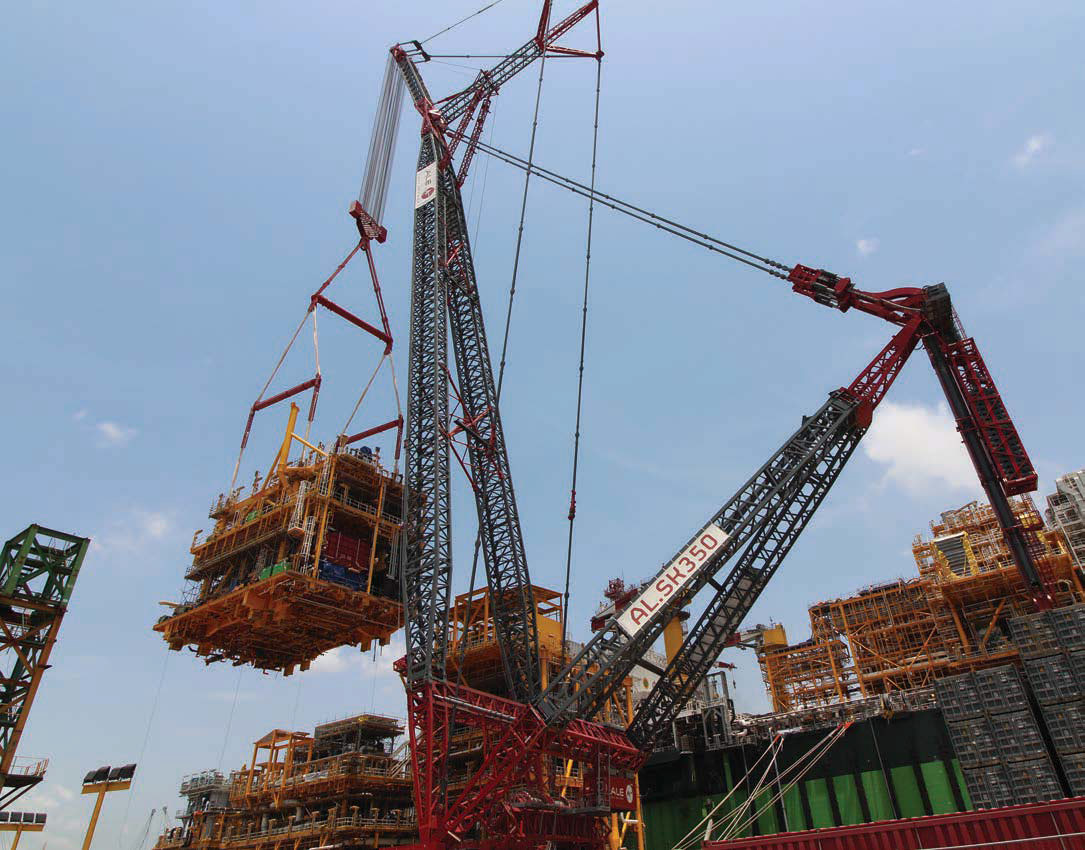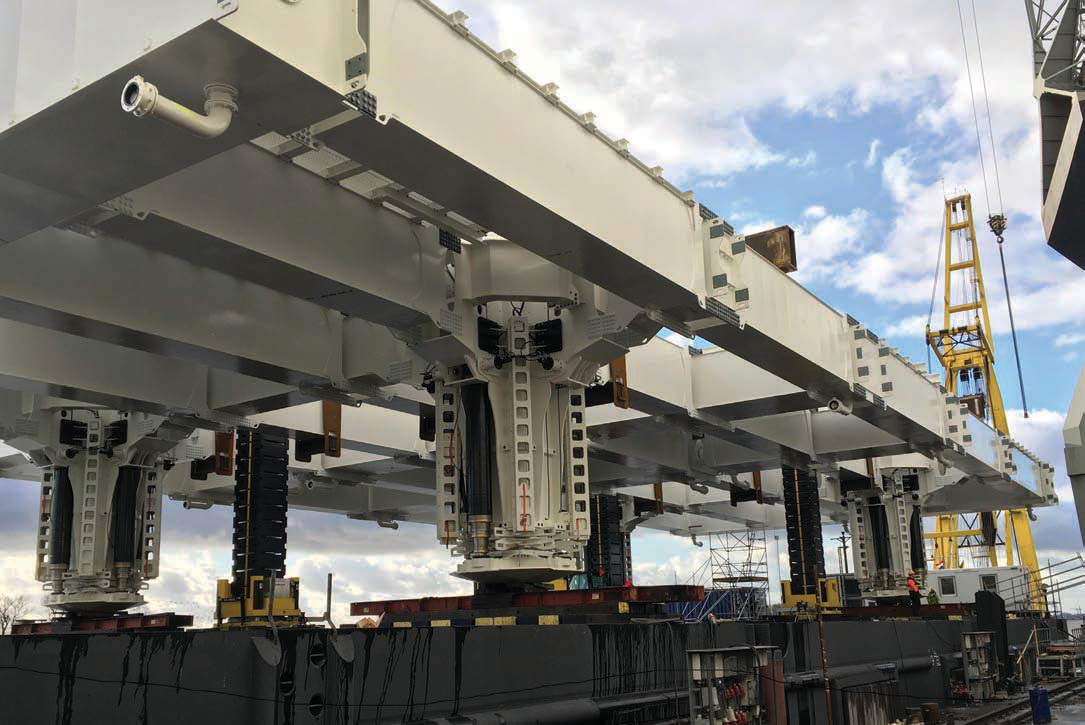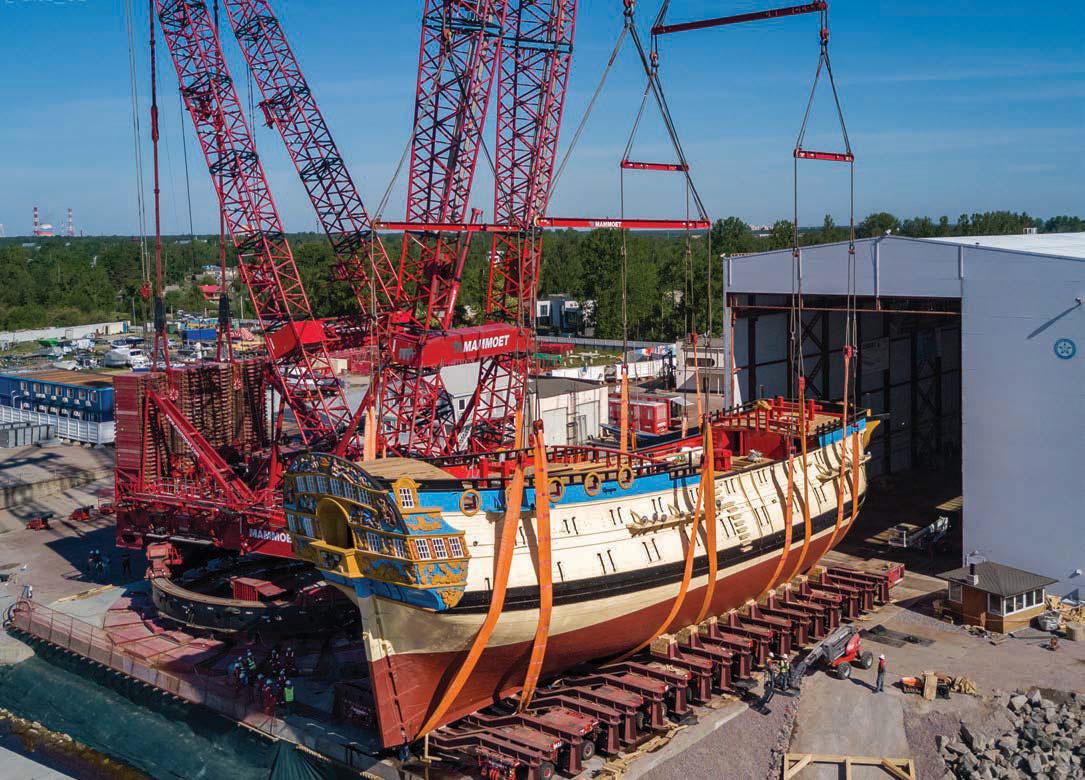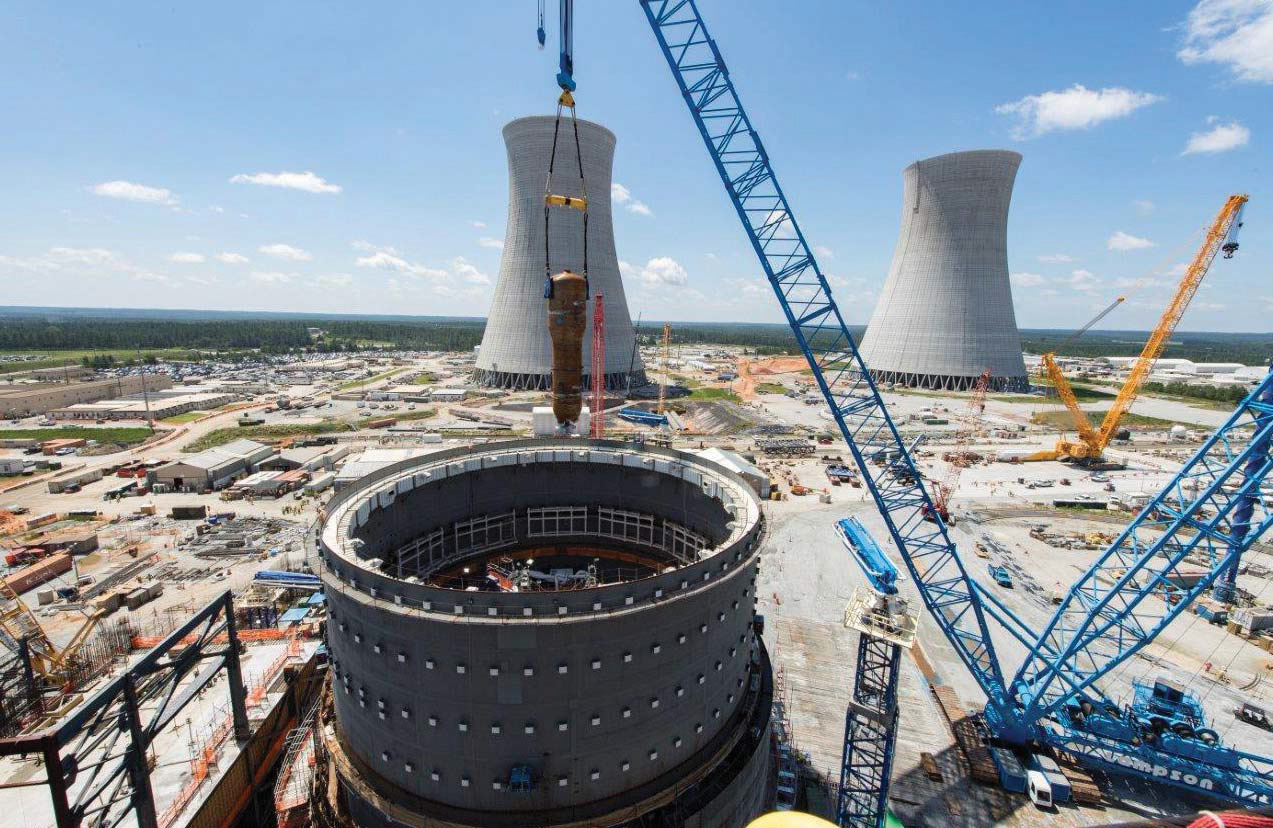Testing the limits
19 September 2018As demand for heavy lifts increases, Sotiris Kanaris looks at equipment with capacities of 1,000t or more and how it has been used in the past year.
From the construction of power plants to the launch of an 18th century battleship replica, the demand for heavy lift equipment has been high in the last twelve months.
Heavy lift companies, crane manufacturers and engineering companies have created a portfolio of products to satisfy the market’s appetite.
The latest crane product that exceeds the 1,000t mark was the Sarens Giant Crane (SGC) 140, which was launched last October.
It has a 140,000tm maximum load moment, a lifting capacity of 2,820t at a radius of 50m, and three different boom configurations of 89m, 118m, and 130m.
Like the pre-existing SGC-120, it is a ring-based heavy lifting machine with a compact footprint with low ground-bearing pressures. The SGC- 140’s first project is in Kazakhstan, where it will be of seminal importance to the completion of a part of the TCO project.
Engineering manager at Sarens Peter Huygebaert told Cranes Today during the launch that the original plan was to use the SGC-120 crane for this job but it wasn’t available, as it was working on an offshore wind project in Sunderland.
“We decided to optimise the new crane specifically for this project, looking at the lifts we are going to do there and how we are going to operate it. At the longest range, it adds 45% more capacity, and at shorter ranges it still adds 15–20%.
We wanted to get as much capacity as possible at 50m radius, and the extra capacity at long reach came from the added counterweight needed for this 50m radius capacity.”
For this project, the crane will be standing in one position, picking up modules and putting them down in a stack.
The SGC family will expand further, as Sarens is working on the SGC-90 and SGC-250 models.
The SGC-250 will be launched in 2019 and will have a maximum load capacity of 3,000t. It will have a maximum boom length of 160m and it can be equipped with or without a jib. It will be able to operate on a ring or on straight rails. The SGC-90 will have a capacity of 90,000tm.
Fellow heavy lift specialist ALE celebrated the ten-year anniversary since the launch of its own crane series for the lifting and installation of ultra-heavy loads, the AL.SK crane series, earlier this year. The AL.SK190 was the first crane to be designed and built by ALE and at 4,300t, was then (in 2008) the world’s largest capacity land-based crane.
ALE developed a solution to enable the crane to rotate around its ballast. It was this that helped to give it such a high capacity as well as an improved outreach.
From its first job lifting a column in Saudi Arabia, the crane illustrated its ability to overcome complex challenges. The latest project where the AL.SK190 was used was the STAR Project in Turkey.
For this job, the crane had to perform over 150 lifts of equipment at the greenfield refinery site in Alia_a, Turkey. The equipment had a combined total weight of 20,000t.
The 14 major heavy lifts involved radiuses ranging from 30–100m and each component varied in weight, with the heaviest piece weighing 1,200t.
The AL.SK190 crane was configured with a 129.9m main mast and 4,000t counterweight ballast.
The ballast design allowed ALE to use only 45° of spreaders, which allowed the client much-needed access to the area. The AL.SK190 did not need a full ring, saving valuable space.
Five years after the development of the AL.SK190, ALE launched its highest capacity crane to date, the AL.SK350. This model has a maximum capacity of 5,000t and a load moment of 354,000tm.
Earlier this year, this crane performed, according to ALE, the heaviest ever land based crane lift. This lift was part of the works on Total’s Egina FPSO module integration project in Nigeria.
The FPSO module ‘S2’ weighed a total load of 2,810t and was lifted using the AL.SK350 crane and 3,400t heavy duty jib for the project in Lagos, Nigeria.
The crane was rigged in its biggest configuration with a 124m a-frame main boom, 49m ballast radius and the 38m jib for additional outreach, along with a heavy winch system and 4,000t ballast.
For Total’s Egina project, ALE was contracted to lift and install six modules from the yard onto their final position on the FPSO. The lift weights were between 335t and 2,810t.
Cees Segeren, technical adviser at ALE, says: “The AL.SK fleet has revolutionised the way the industry perceives crane lifting and has had many notable achievements in the last ten years. One of the great advantages of the cranes is that they can operate in a small space and this was showcased recently during renovation works at Earls Court in London, UK. Other demolition works could continue, which pleased the clients as they saved time and costs.”
ALE also has pedestal cranes in its fleet with capacities exceeding 1,000t, the 1,200t AK912-1 and MK1500. They were both made by Gottwald and have undergone modifications by the heavy lift company.
The AK912-1 was recently used alongside one 750t capacity and two 300t capacity cranes to discharge and assemble the 51 wind turbines for the Walney Extension offshore wind farm in Belfast, Northern Ireland. Dutch heavy lifting and transport provider Mammoet has its own in-house designed extremely high capacity cranes: the PTC 200-DS, the PTC 140-DS, PTC 35, PT 50 and MSG 80.
The largest one is the PTC 200 DS, which reaches with its maximum lifting capacity of 3,200t at a radius of 50m. This corresponds to a load moment of 200,000tm.
“Ring cranes answer a wide variety of today’s lifting challenges by combining lifting capacity with a long reach, small footprint, flexible configuration and quick mobilization,” says Mammoet.
Earlier this year the company used the PTC 200-DS to perform lifts at Lotte Chemical’s Mono- Ethylene Glycol project in Louisiana, USA. For this project the crane reached record highs.
The lifts executed by Mammoet ranged from 30t to 1,600t. The largest of these was the wash tower, which is over 100m high. Following that lift, the PTC 200 DS was reconfigured to include an additional 220ft (67m), bringing the total reach of the crane to 713ft (217m). This is the tallest the PTC has ever been on a job site.
The configuration allowed the crane to remain in one location and execute lifts of modules located outside the original lifting radius, thus keeping lifting activities consistent and eliminating downtime associated with crane relocation.
Patrick van der Meide, vice president of sales and marketing at Mammoet USA, says: “With this project, we were able to demonstrate that the PTC’s value extends beyond lifting oversized and heavy objects. It was the ability of this crane to reach smaller modules and execute various lifts outside the original lifting range which ultimately delivered greater efficiency, enabling the scope to be completed safely and successfully ahead of schedule.”
Another recent project where a PTC crane was used, involved handling the replica of Russia’s first 54-gun battleship, which dates from the 18th century. The 1,200t capacity PTC 35 was used to lift and launch the 600t Peter the Great’s Poltava battleship replica in in St. Petersburg, which will be used as a floating museum.
USA-based Lampson International is also specialised in the heavy lifting market. Kate Lampson, director of director of strategic communications, says: “We do a lot of work in the oil and gas industry, power plant construction of all types including the nuclear industry as well as heavy structures such as stadium construction and bridge construction.”
Lampson has its own range of high capacity cranes called the Lampson Transi-Lift (LTL) series. The Transi-Lift System is a patented configuration that combines the heavy lifting capacities of stiff leg derricks and ring mounted lift equipment with the mobility of a conventional crawler crane.
The concept of the Lampson Transi-Lift was developed in the 1970s by Kate’s grandfather Neil, and the range comprises of six cranes with capacities from 350USt to 3,000USt.
The largest model in the fleet is the Lampson Transi-Lift LTL- 3000, which boasts a 3,000USt front crawler capacity, 400ft of Lampson Pin-Together main boom, two different jib styles and hydraulic hoists with electronic finger tip control. This crane is fully mobile under load and can be easily transported by conventional trucks.
Over the years approximately 50 Lampson Transi-Lifts have been built, of which around a dozen have been sold to companies in countries around the world, including China and Japan.
Lampson says there has been an increase in demand from heavy lifts. “We have seen an increase in demand over the years, mostly due to more refineries coming back on line and investing in shut downs and replacements of componentry.”
Lampson’s LTL-2600 has maximum capacity of 2,600USt and has up to 460ft of main boom and up to 240ft. One unit of this model has been working at Plant Vogtle in Georgia over the past year and a half, performing numerous lifts.
The construction involves Plant Vogtle units 3 and 4, which according to Georgia Power they will be the first new nuclear units built in the United States in the last three decades.
Crane manufacturers
Some of the ‘traditional’ crane manufacturers have tried to expand their range in order to accommodate the needs for heavy lifts.
In Terex’s portfolio there are three Demag crawler cranes with capacities exceeding 1,000t: the 1,250t lifting capacity Demag CC6800-1, which has a maximum load moment of 13,840tm; the CC 8800-1 with capacity of 1600t and a maximum load moment of 26,160tm; and the CC 8800-1 TWIN crawler crane which has a nominal capacity of 3200t and a maximum load moment of 43,900tm. The manufacturer also offers the AC 1000-9, an all terrain crane with capacity of 1,200t.
A number of units from these models have been sold to heavy lift companies and large crane rental companies.
Sarens has Demag CC6800-1 and CC 8800-1 cranes in its fleet. It recently put a Demag CC6800-1 to work performing component lifts at the NIS Refinery in Pancevo, Serbia.
Naftna Industrija Srbije (NIS) JSC, began the construction of its bottom-of-the barrel (BOTB) complex to improve energy efficiency and increase production. Sarens was chosen to perform the load-out, transport, jacking, skidding, and lifting of equipment, two coke drums under a pipe rack, and steel constructions at Pancevo in Serbia.
The CC 6800 with SSL 114m configuration, travelled from Rostock, Germany, by road. The crane was rigged in a congested area, as there was only one access road of 130m x 12m.
Liebherr also has a range of crawler cranes with capacity hitting the 1,000t mark. It includes the 3,000t LR 13000, the 1,350t LR 11350 and 1,000t LR 11000 crawlers.
Mammoet recently used an LR13000 for the expansion of a Gulf Coast polypropylene plant. With its 96m power boom rising high into the sky, the LR13000 was strategically placed to lift and install both reactors from one position. The crane was outfitted with a complex boom configuration, boasting a lifting radius of 33.5m and superlift capacity of 1,500t. The larger reactor weighed a total of 725t and stretched 49m long. These lifts were executed successfully with tailing help from one of Mammoet’s Terex CC 2800 crawler cranes.
Earlier this year an LR 11000 was used by Emil Egger to install a silo with a capacity of 470m3 for a concrete mixing plant in Oberriet, a Swiss municipality on the border with Austria.
Managing director Michael Egger explained the reason for using such a powerful crane to handle a gross load of 140t with a maximum radius of 16m. “The benefit of our solution was that using the LR 11000 for this job meant that a derrick jib was not required as would have been the case if a 500t crawler crane had been used. That would have presented a massive problem as a result of the extremely constricted space available.”
In Liebherr’s product offering there is also the 1,200t LTM 11200- 9.1 mobile crane. Max Bögl Group operates four of the LTM 11200-9.1 cranes and it recently employed one of them to assemble three Liebherr 630 EC-H top-slewing tower cranes for an energy storage project.
Beyond cranes
Apart from cranes there are other technologies that execute heavy lifts, including gantries, strand jacks and jacking up systems.
ALE recently launched the TLG1000 telescopic lifting gantry, which has 1,000t capacity on four towers. The new gantry system has been designed with a variable track width, which means it can run on standard 915mm wide tracks to 1,750mm wide tracks.
The three-stage system has 1,000t capacity at all stages, up to 12m high. Technical director at ALE Ronald Hoefmans, says: “We have the tower with the sliding support on top, we slide it in, jack up the first stage. Then we have locking pins, locking that stage, then the sliding support opens picking up the next stage. This is how we climb up.”
He says the TLG1000 has 6% side load capacity, four times higher than the SMP30 industry standard. Since its launch it has been employed in projects in South America. It is expected to be typically used on power plants to lift loads from trailers, or out of girder frame trailers, and move them around on site to install on their foundations.
Another gantry in the market with capacity over 1,000t is the Enerpac SBL1100 hydraulic gantry, which can lift loads up to 1,069t. In Enerpac’s product range there are a numerous products that are suitable for heavy lift applications.
One of the most popular lines is the jack-up systems, which includes the JS125, JS250, JS500, JS750— the number indicates the capacity of each tower in metric tones.
Earlier this year, Enerpac’s JS- 250 Jack-up system, comprising four towers, was used for the assembly of a large maritime platform at ground level before raising the platform 7m for installation of supporting legs. Measuring 28m wide and 56m long, the quayside platform including 16 telescopic legs has a total weight of 820t.
“The JS-250 Jack-up system is ideal for assembly of large steel frameworks,” says Jeremy Stubbs, UK sales & global product manager, Enerpac Heavy Lifting Technology.
“For the maritime platform, the Jack-Up system allowed safe working at ground level while enabling the platform to be raised to 7m and mechanically secured over an extended period.”
Another part of Enerpac’s heavy lifting technology are strand jacks. Bigge Crane and Rigging recently used Enerpac HSL 5000 strand jacks to lift the pier tables of the Gerald Desmond Bridge on Long Beach, California.
John Levintini, projects operations manager at Bigge Crane and Rigging, said, “It would have been impractical to use a crane given the size and weight of the pier table. The strand jack is the best choice in terms of both lifting capacity and cost.”
Another recent bridge project were a jacking up system was used was the Zwolle Bridge in the Netherlands. The 950t, 108m long bridge, which is being built by ProRail, will cross over the train tracks at the Zwolle train station and serve about 1,200 buses per day. Sarens used four of its in-house designed CS450 towers, with a capacity of 450t each, to jack the bridge about 8m above ground level.
As the demand for heavy lifts continues and the loads are getting heavier, the question arises as to whether heavy lift and engineering companies will be able to manufacture equipment with even larger capacities than the current ones. One thing is for sure, they are already looking into it.
